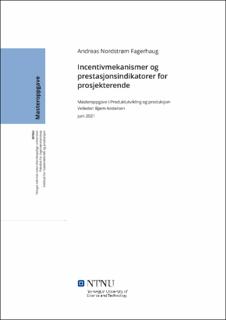| dc.contributor.advisor | Andersen, Bjørn | |
| dc.contributor.author | Fagerhaug, Andreas Nordstrøm | |
| dc.date.accessioned | 2022-02-01T18:22:30Z | |
| dc.date.available | 2022-02-01T18:22:30Z | |
| dc.date.issued | 2021 | |
| dc.identifier | no.ntnu:inspera:78072291:23129753 | |
| dc.identifier.uri | https://hdl.handle.net/11250/2976445 | |
| dc.description.abstract | Denne masteroppgaven undersøker hvilke incentivmekanismer og prestasjonsindikatorer som brukes i dagens prosjekteringskontrakter i den norske bygg- og anleggsbransjen, hvilke andre løsninger som er relevante og hvordan bransjen skal klare å implementere nye metoder.
En utfordring er at de mest brukte kontraktene for prosjekterende, fastpris og regningsarbeid, ikke benytter seg av incentiver eller gjenspeiler levert verdi fra prosjekterende til prosjekter. Dette fører til lavere produktivitet, ujevn fordeling av profitt og lite samarbeid mellom de forskjellige aktørene i prosjekter.
Forskningen gjort i denne oppgaven er basert på en kvalitativ metode som består av et tradisjonelt litteratursøk, en multiple-casestudie og intervju. For å kartlegge den nåværende statusen av innovative kontrakter i dagens bransje, ble seks kontrakter samlet inn for sammenligning og analyse. Videre ble det utført syv intervjuer med personer i bransjen for å få en dypere innsikt i dagens problematikk og mulige løsninger for veien videre.
Funnene viser at det er det er stor andel av de tradisjonelle kontraktene NS 8401 og NS 8402 som benyttes mot prosjekterende. Noe av problemene med disse kontraktene er at de er utdaterte og ikke tilpasset hvordan prosjekterende arbeider i dag. Kontraktene verken motiverer til samarbeid mellom aktørene eller belønner prosjekterende for å være kreativ og komme med bedre løsninger. Av de seks innsamlede kontraktene bygger fem av de på samspill. Likevel er det stor forskjell i hvordan de er bygd opp og hvilke tilhørende kontrakter som benyttes.
Videre ble det sett på hvilke incentiver og indikatorer som kan implementeres for å bedre tilrettelegge fordelingen av økonomisk gevinst og oppmuntre prosjektdeltakerne til å jobbe for prosjektets beste. Intervjuobjektene fra prosjekterende og byggherre stiller seg positiv til å implementere incentiver rettet mot prosjekterende. Her trekkes de to mest relevante forslagene frem. Det første forslaget er å ha incentiver knyttet til målpris med samspill, prestasjon og fremdrift. Det andre forslaget er å ha incentiver rettet mot energiforbruk over i driftsfasen av leveransen.
Oppgaven avslutter med å se på hvordan nye metoder kan implementeres i bransjen. Her trekkes bestillerkompetanse, holdningsendring blant prosjekterende til å ta risiko og standardisering fram som sentrale tema. Gevinstene ved å implementere incentiver er blant annet at det vil skape en prestasjonsbasert kultur, belønne de som arbeider bra og ha felles incentiver for å sikre et felles mål og samarbeid på tvers av aktørene. Utfordringene er at bygg- og anleggsbransjen kan være konservativ, det krever endring fra de andre aktørene og at gjennomføringsmodeller, kontrakter og incentiver er et komplekst tema. | |
| dc.description.abstract | This master's thesis examines which incentive mechanisms and performance indicators are used in current engineering consultant contracts in the Norwegian construction industry, which other solutions are relevant and how the industry will be able to implement new methods.
A challenge is that the most commonly used contracts for engineering consultants, fixed price and billing work, do not use incentives or reflect value delivered from the engineering consultants to projects. This leads to lower productivity, uneven distribution of profits and insufficient cooperation between the various participants in projects.
The research conducted in this thesis is based on a qualitative method which consists of a traditional literature search, a multiple-case study and interviews. To map the current status of innovative contracts in today's industry, six contracts were collected for comparison and analysis. Furthermore, seven interviews were conducted with people in the industry to gain a deeper insight into current issues and possible solutions for the future.
The findings show that there is a significant share of the traditional contracts NS 8401 and NS 8402 used towards engineering consultants. Some of the problems with these contracts is that they are outdated and not adapted to how engineering consultants work today. The contracts neither motivate for collaboration between the participants nor reward engineering consultants for being creative and coming up with better solutions. Of the six contracts collected, five of them are based on collaboration. Nevertheless, there is a big difference in how they are structured, and which associated contracts are used.
Furthermore, the focus was directed towards which incentives and indicators can be implemented to better facilitate the distribution of financial gain and encourage project participants to work for the project's best interests. The interview objects representing the engineering consultant and the construction client are all in favor of implementing incentives aimed at engineering consultants. The two most relevant proposals are presented here. The first proposal is to have incentives related to the target price with collaboration, performance and progress. The second proposal is to have incentives aimed at energy consumption during the operational phase of the delivery.
The thesis concludes by looking at how new methods can be implemented in the industry. Here, customer competence, change of attitude among engineering consultants to take risk and standardization are highlighted as central topics. The benefits of implementing incentives are, among other things, that it will create a performance-based culture and reward those who work well. Shared incentives will ensure a common goal and cooperation across the participants. The challenges are that the construction industry can be conservative, it requires change from the other participants and project delivery models, contracts and incentives are a complex topic. | |
| dc.language | nob | |
| dc.publisher | NTNU | |
| dc.title | Incentivmekanismer og prestasjonsindikatorer for prosjekterende | |
| dc.type | Master thesis | |
